Leeham News and Analysis
There's more to real news than a news release.
Pontifications: Jets took 30 years to match piston efficiency

The Douglas DC-6B was considered the finest, most efficient and most reliable of the piston engine airliners. Photo via Google.
Aug. 28, 2017, © Leeham Co.: Airline officials want their airplanes to sip fuel and the engine and airframe manufacturers work mightily to shave even 1% off of consumption.
The Airbus A320neo, Boeing 737 MAX, A330neo, A350 and 787 all made big strides in cutting fuel costs.
Bombardier’s CSeries, Embraer’s EJet-E2, the Mitsubishi MRJ and even the COMAC C919 and Irkut MC-21 are touted to be double-digit more fuel efficient than the jets these are intended to replace.
Pratt & Whitney, Rolls-Royce, CFM and GE Aviation spend billions of dollars developing engines that drive the fuel efficiencies sought by the airlines. After all, typically airframe improvements only account for about 5% of fuel reductions. Engines account for 15% or more.
It took 30 years for the most fuel efficient jets matched the fuel efficiency of the best piston airliners from the 1950s, according a recent presentation by AeroDynamics Advisory at the ADSE conference at the Abbotsford Air Show early this month.
From the pistons to the jets
It was no secret that the first Boeing 707s, Douglas DC-8s and de Havilland Comets were incredibly thirsty compared with the pistons these replaced. The speed, higher utilization and greater passenger capacity are what gave jets the operating advantage over the Douglas DC-4s, DC-6s, DC-7s and the grand Lockheed Constellations of the 1950s. The DC-6B was considered the most efficient, reliable piston engine transport ever made. The ungainly Boeing Stratocruiser was considered the worst from an operational standpoint, even if popular with passengers.
The reliability of the jet engines proved, over time, to be so much better than the pistons as well.
It wasn’t until the advent of the high bypass turbofans that jet airplane finally matched the efficiency of the pistons, AeroDynamics said, citing a study, “Fuel Efficiency of Commercial Aircraft.”
Future regulations
ICAO, the international organization that issues rules and regulations for airlines and aircraft that are internationally recognized, approved a new CO2 standard that has an effect of requiring better fuel efficiency for newly certified aircraft from 2020 and in-production aircraft from 2023.
The following chart is not all-inclusive—the Bombardier CSeries, Embraer EJet-E2 and several other models are not listed. What catches the eye is the Airbus A380 won’t be compliant in its present iteration. Presumably an A380Plus would be, since winglets alone will reduce fuel consumption by an estimated 4%. Other aerodynamic improvements will help (remember, this standard is about CO2 reduction, not a per-seat calculation).
ICAO’s paper on the regulations may be found here. The Tables below have the complete aircraft listing ICAO evaluated, including business aircraft, and rated. The “plus” (+) figure means the aircraft fails the new standard. The “minus” (-) figure means the airplane passes the new standard. The greater the minus number, the more “room” the airplane has to the new standard.


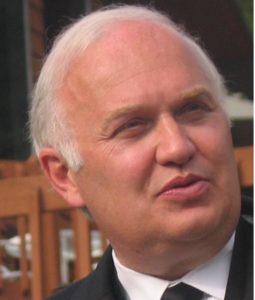
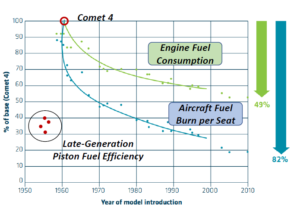
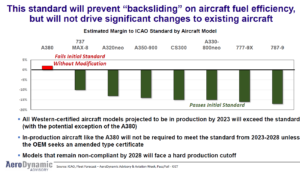
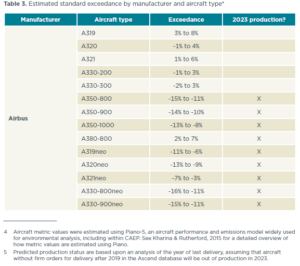
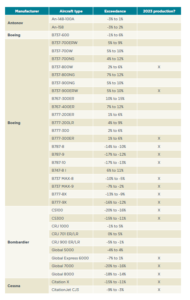
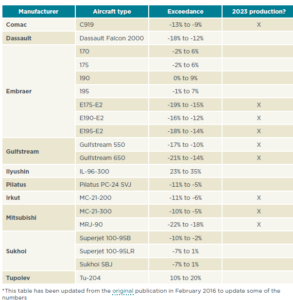
Think the Napier Nomad was the piston Engine with lowest TSFC.
@ 0.210 kg/kWh quite probable.
( modern “LARGE” 2 stroke marine diesel engines top out a ~165g/kWh. better than 55% thermal efficiency )
Another comparison:
The Junkers opposing piston diesel engine Jumo205 from ~1936
has @235g/kWh similar sfc to
the current best of class TP400 turboprop engine for the A400M
(Best numbers for non turbo compound radial engines
seem to not go below 285g/kWh. Anyone got better reference?)
Maybe I’m a bit thick, but what are they measuring?
lobbyist influence? 🙂
I really don’t get the metric their computations are based on?
IMU this looks like every class member has to improve over a demarcation line determined by “average plus margin” .( thus forcing the higher emitters to improve more. )
.. but independent of tech state of the groups sample types?
i.e. the core group containing more rather old types has to improve less for newer frames overall than those groups with solely recent types.
Probably the reason why A380 is getting negative there? Not many aircrafts are at A380 mass group
There is a paper by the NLR available, that explains in more detail the energy consumption of the 1950ies props.
https://www.transportenvironment.org/publications/fuel-efficiency-commercial-aircraft-overview-historical-and-future-trends
The graphs shown above are partly based on that report, which is dated 2005.
Thanks for the link. Actually the report is mainly about pistons vs. jets/turbofans, with only a few mentions of turboprops (including a graph showing their market share peaking at around 20% in the late 1960s). I found some stats for a few notable turboprop engines/aircraft below. It’s notable that the NK-12 came within 5% of the SFC of the Napier Nomad in the 1950s, but AFAICT no turboprops have bettered that SFC since.
Engine (aircraft, year)Specific fuel consumption (kg/kWh)Power-to-mass ratio (kW/kg)
Kuznetsov NK-12 (Tu-95, 1952)0.2193.7
P & W Canada PW127M (ATR 72-600, 2007)?3.44–3.83
P & W Canada PW150A (BBD Q400, 1998)?4.76
Europrop TP400-D6 (A400M, 2009)0.2384.41
Progress D-27 (An-70, 2015)0.2416.33
[Reformatting the table…]
Engine (aircraft, year) | Specific fuel consumption (kg/kWh) | Power-to-mass ratio (kW/kg)
Kuznetsov NK-12 (Tu-95, 1952) | 0.219 | 3.7
P & W Canada PW127M (ATR 72-600, 2007) | ? | 3.44–3.83
P & W Canada PW150A (BBD Q400, 1998) | ? | 4.76
Europrop TP400-D6 (A400M, 2009) | 0.238 | 4.41
Progress D-27 (An-70, 2015) | 0.241 | 6.33
The words in the ICAO’s overview are:
“Under the standard, an aircraft type’s fuel efficiency will be evaluated on ICAO’s metric value (MV), a proxy of cruise fuel efficiency that is calculated as function of an aircraft’s specific air range (SAR) and Reference Geometric Factor (RGF), which is a close approximation of the pressurized floor area of the aircraft. In order to be certified under the standard and sold internationally, each aircraft/engine combination produced by a manufacturer will need to meet a MV limit, assigned as a function of its maximum takeoff mass (MTOM) and measured at three equally weighted gross weight test points.”
Could someone please explain that to us simple folk?
Floor area × Distance flown with a fixed amount of fuel (after numerous calculation)→ MV, and the limit on MV is taken from other aircrafts with same MTOW
Hello Scott,
Regarding Icao regulations, it looks like it is based on “mean values” by family decrease by a margin for the future regulation
Then single aisle or twin aisle families with both new (A320NEO, MAX, 787) and old type (767, NG, CEO, 777) are less a challenge for “current airplane” than the VLA family with only the 747-8 and the A380-800 that are both modern… and both not complying with the future goals.
Not sure i’m clear 😀
Best regards
Thanks to those who have tried to untangle these regulations. I still don’t understand, but I have now seen enough to confirm my initial judgement.
You are perfectly clear, the strange grouping is including passanger jets in the average present number calculation that sells/produced less than 12/year like the 767 passanger jet where deliveries are purely cargo and military. (soon the A380 is there as well <12/year unless they improve it and keep the Customer perceived Comfort and upper class bar…)
At least there is now an absolute can’t exceed end date for the A380 will they won’t they saga.
Why does the 787/9 perform so much better? If I understand correctly, every plane will pass, so what’s the point of these regulations? Just look busy and everyone will think we’re doing something useful.
The 787 group also has the 767 with its neanderthal engines as member. Thus the group average ( base for computing the future “do not exceed” target is much higher to begin with.
Simple lobbying. Works perfectly.
If derivation of metrics looks “complex” and opaque there is something hidden in the shadows.
To me the most important issue is the lack of efficiency of even the newest aircraft on offer. To achieve a level of efficiency that was last achieved by ircraft in the 1950s is pretty pathetic.
Why is it that short haul aircraft do not revert to prop driven from whatever is the most efficient propulsive system. Diesel electric maybe in a lifting body and the props run using electric motors.
If we were at all serious about emissions then shorthaul hops up to 2 hours should be serviced solely in this manner. Any loss in speed would be sufficiently small to be acceptable. It certainly would change the current single aisle dynamic which is currently in a A320esque rut.
It is almost as though all OEMs are fixated on refining the past rather than considering the potential for a step change in efficiency
Because passengers prefer the perceived speed and comfort of an Embraer or CRJ/CSeries over an ATR or Q400.
Apples and dirt comparison
Take your point but if there is an issue of fuel cost or emissions controls as was the case or will be increasingly the case I still don’t see it. The only problem I foresee is the noise of props
Further if the regulator believes emissions are truly important we are imposing controls that were last met in the 1950s, hardly very aggressive. You could argue the regulator is happy with status quo minus 1 percent, a token and no more
Not even a token, the market is far more demanding than the regulator. It’s obviously been carefully designed that way. There’s only so much that the manufacturers can do and these regulations just track the market, with a considerable amount of leeway.
Remember, the jets are cruising at 1.7 or more the speed of the old pistons. Power required goes up at something like the cube of speed (energy required goes up as the square of velocity but because propulsive efficiency declines with velocity you need about the original power doubled three times to go twice as fast).
You can’t make a piston engine (or turbine for that matter) using a propeller powerful enough to cruise at mach .85. So given the cruise speed difference between the final piston airliners and the jets these “efficiency” comparisons are really quire meaningless.
It is just a matter of Power and prop efficiency. The Tu-114 was able to reach speeds typical of modern jetliners (880 km/h), but its cruising speed equivalent to Mach 0.71 was markedly lower than equivalent jet airliners such as the Boeing 707, Douglas DC-8, and Vickers VC10, which usually cruised at Mach 0.83, so with todays CFD codes and carbon fiber reinforced plastic designs the counter rotating props should push this limit further towards M=1. Safran Snecma prototype UDF when moved to a flying testbed will show it.
it would be interesting to see where aircraft piston efficiency and reliability would be if the level of engineering effort that has been put into turbines over the last 70 years had been put into pistons. Automotive piston engines are not really a good measure because they are heavily compromised for broad RPM range performance, where an aircraft engine would be heavily optimized for very narrow RPM range, nor do they take advantage of many of the exotic materials available in turbines. even the most exotic racing classes are heavily compromised in this manner by regulations restricting engine materials to a small list of tightly specified alloys (for cost reasons).
throw in 70 years of structure and aero improvements and I would expect that a truly modern piston twin would destroy a modern turboprop in efficiency.
Brake specific fuel consumption is very misleading.
With piston engines the specific fuel consumption increases dramatically at lower loads, together with dramatic increases in lubricating oil consumption.
Realistically comparisons between piston engines and turbines is irrelevant.
The huge advantage of turbines is simply less moving and wearing parts.
The piston engine made a fantastic contribution to aviation, but it has had its day.
It still is the power of choice at the low end.
Again, the problem is at the high end to get it light, efficient and working you have to get exotic.
I’ve see the turbo super compound engines. What a nightmare in row 2 let alone row 4(?).
And bad enough that you can hardly find the spark plugs in row 1.
To make this more clear, Sowerbob says pathetic, its not.
First and foremost, DC-6 was the max size you were going to get that was efficient and reliable (non flying boat and those were far worse).
Passengers: 42 to 89. 707? – 140 to 219.
Pretty close to 3 time the pax
So lets look at the Next Gen Piston: Mother of all engines turbo super charged assisted drive on the Constellation. A million moving parts, a nightmare to service, unreliable and not likely to get much more so (some yes, a lot, not)
So, take the state of the metallurgical art and the Jet was a wonder for thrust a piston could NEVER achieve (turbo prop yes, but that’s just another jet with a prop isn’t it?)
Sure you can get reliable high hp piston engines, you find them in tankers and freighters. The are 100 feet long, 40 feet high and weight a bazillion tons. Want to drive a prop, yep, speed up gears, they turn at 150 rpm (high end)
The reality is if you want to build something bigger, you paid huge for it vs going with jet engines.
And a piston was never going to get there anyway.
And it tells you how hard it all is when it takes this long to achieve parity.
A better metric would be to compare a DC-6 to a 707 is fuel used per passenger on identical flights.
That does not mention that a jet can get above the weather, that’s hugely significant.
I spent my time wallowing around in weather in a DC-3/4/6.
I also got an early DC-8 flight, now that was a trip.
The next generation of jet Engines might have a “cylinder and piston” type of constant volume combustion chamber to reach much higher pressures at combusiton than todays “constant pressure” Brayton cycle and have a UDF type of counter rotating props. It will not look like a P&W R4360 Wasp Major and more like a UDF but the thermodymanic efficiency happens inside a cylinder and the propulsion thru “prop” blades.
Uh, no. Constant volume combustion will be achieved in a steady manner using continuous rotating wave detonation. No need for pistons, cylinders, or (for that matter) intermittent combustion.
How about Bristol Britannica?
I can’t resist: The Britannica is a great encyclopedia. The Britannia was a middling turboprop.
I am delighted you took the click bait TW, we are comparing shorthaul transport regarding efficiency and emissions, I am simply saying that we are stuck in a paradigm dictated by turbofan technology that has finite gains at immense cost. You seem willing to accept this as the status quo. I believe there are considerable gains to be made with disruptive tech along the lines of tesla cars and the auto industry that fundamentally change the goalposts. Not fully electric for aircraft (sorry Bjorn) but looking at the options out there then we must consider alternatives.
In Europe we see serious emissions issues that may not be apparent in Alaska and sooner or later emissions, not oil price will dictate air travel
Another advantage of jets is the fuel used. It’s way less exotic than that required by the high performance piston engines of the ’50s – no?
Napier Nomad and the Soviet Svezda M520 engine were Diesel compound.
The US types were based on Otto cycle petrol core engines.
“exotic” i.e. high octane ratings probably was less of an issue than flammability/flash point temps inherent dangers.
The biggest advantage for jets, was the price of fuel back then. Cents per gallon.
We are looking back at ‘efficiency’ with modern eyes.
The graph probably missed an [x] next to Pilatus PC-24, no reason to think it won’t be in production in 2023